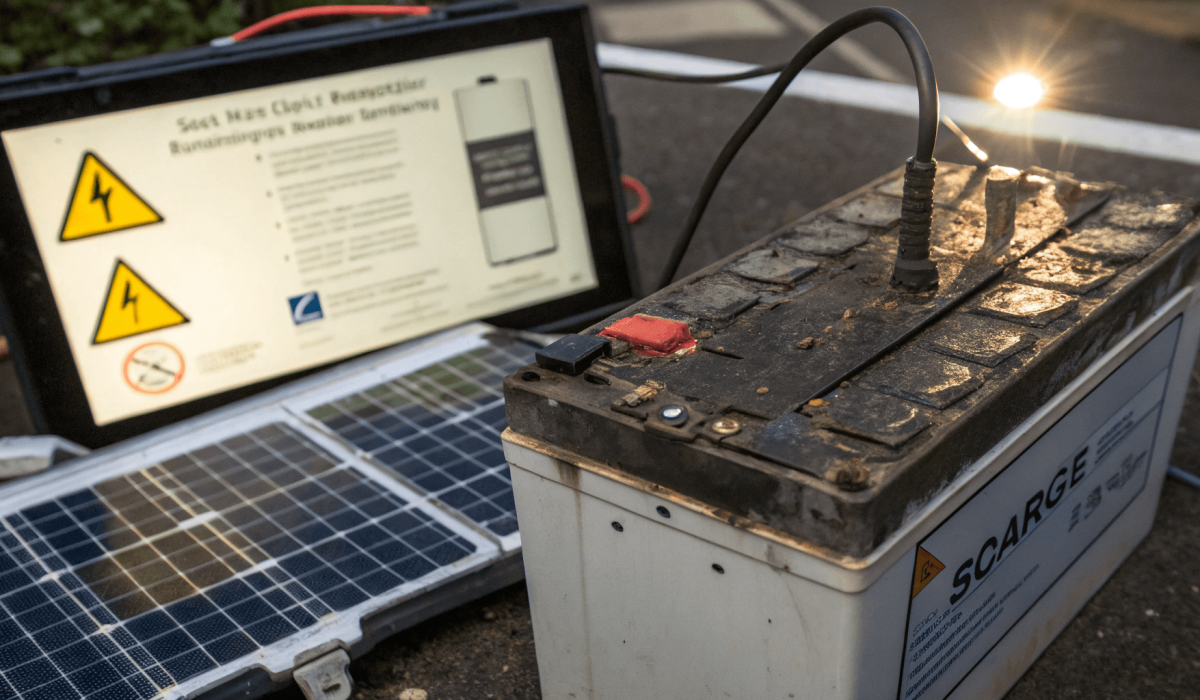Why Battery Choice Can Make or Break a Solar Street Light Project
In solar street lighting, the battery is not just a component—it’s the heart of the system. Panels capture sunlight, but without reliable storage, lights fail after dark. I’ve seen projects in Tanzania where lights went dark in less than three years, not because of the solar panels or LEDs, but because the batteries degraded too quickly.
When it comes to modern systems, the choice usually comes down to Lithium-ion vs LiFePO₄ for solar street lights. Both fall under the lithium battery family, but their performance in the field is strikingly different. The decision impacts not only upfront cost, but also lifespan, safety, and total project ROI.
Understanding the Two Technologies
Lithium-ion Batteries
- Chemistry: Most solar street lights use lithium cobalt oxide (LCO) or lithium manganese oxide (LMO).
- Strengths: High energy density, compact size, relatively low upfront price.
- Weaknesses: Shorter cycle life (~2,000 cycles), more sensitive to heat, and higher risk of thermal runaway.
- Typical applications: Consumer electronics, some EVs, small-scale solar kits.
LiFePO₄ Batteries
- Chemistry: Lithium iron phosphate, designed for stability and long cycle life.
- Strengths: ~4,000–6,000 cycles, safer under high temperatures, longer service life (8–12 years).
- Weaknesses: Lower energy density, bulkier, higher initial cost.
- Typical applications: Industrial solar systems, electric buses, energy storage banks.
Key Comparison: Lithium-ion vs LiFePO₄ for Solar Street Lights
| Feature | Lithium-ion | LiFePO₄ |
|---|---|---|
| Cycle Life | ~2,000 cycles (≈3–5 years) | ~4,000–6,000 cycles (≈8–12 years) |
| Safety | Risk of overheating, fire in rare cases | Very stable chemistry, minimal fire risk |
| Energy Density | 150–250 Wh/kg → smaller, lighter | 90–160 Wh/kg → bulkier |
| Temperature Range | Performance drops above 35°C | Stable in 45°C+ climates |
| Cost | Lower upfront ($80–$120) | Higher upfront ($150–$250) but fewer replacements |
Lifespan in Real Projects
In Nairobi, I’ve seen lithium-ion batteries in solar parking lights start losing capacity after year three. By comparison, LiFePO₄ units in coastal Mombasa have been running past year seven with minimal drop in performance. That difference alone saved the city thousands in replacement costs.
Safety and Reliability
Safety isn’t always top-of-mind in procurement, but it should be. Lithium-ion systems can overheat if poorly managed. In hot northern Kenya, where summer daytime temperatures regularly hit 38°C, I’ve seen lithium-ion lights dim early in the night because batteries were stressed. LiFePO₄, on the other hand, is almost immune to these failures.
Energy Density vs Practical Deployment
Lithium-ion wins in energy density, making it lighter and more compact. This matters for sleek designs in residential estates or private projects. But for municipal-scale lighting where poles are already heavy-duty, the size trade-off of LiFePO₄ is rarely an issue.
Cost and ROI
At first glance, lithium-ion seems attractive with its lower upfront price. But when you calculate 10-year ownership cost, LiFePO₄ usually comes out cheaper.
- Lithium-ion: replace twice in 10 years → total ≈ $200–$240.
- LiFePO₄: replace once in 10 years → total ≈ $150–$250.
👉 This is why I often advise governments: “Don’t look at the purchase invoice, look at the replacement schedule.”
Which Battery Fits Your Project?
- LiFePO₄ is the clear choice if you want long-term performance, especially in hot or coastal regions, or if you’re designing for public infrastructure where reliability is critical.
- Lithium-ion can still make sense for budget-sensitive projects, temporary setups, or designs where space and weight are a concern.
In my projects across East Africa, 8 out of 10 installations now specify LiFePO₄. Contractors are realizing that lower maintenance costs and fewer replacements outweigh the upfront expense.
Common Questions I Hear From Clients
Why not just use lead-acid?
Lead-acid batteries are cheap, but they last only 2–3 years, require frequent maintenance, and can’t handle deep discharges well. Most modern tenders now exclude them.
Can I upgrade an existing lithium-ion system to LiFePO₄?
Yes, but you’ll need to ensure the controller supports LiFePO₄ charging parameters. Some universal controllers can handle both chemistries.
Do both battery types require the same installation process?
Physically yes, but LiFePO₄ often needs slightly more space due to bulk. Weight distribution on poles should also be considered.
Looking Beyond the Batteries
One thing rarely discussed in tenders is end-of-life recycling. As LiFePO₄ adoption grows, questions around recycling infrastructure will matter more. Another challenge is supply chain volatility—lithium prices have swung wildly in the past five years, affecting both chemistries.
I believe the future lies in LiFePO₄ becoming the default for solar street lighting, especially in Africa’s hot climates. But procurement practices must also evolve—factoring in not only purchase cost, but also recycling, logistics, and lifecycle ROI.
Final Thought
Choosing between Lithium-ion vs LiFePO₄ for solar street lights isn’t just about technology specs. It’s about matching the battery to the environment, budget, and long-term expectations of the project.
The real question is not “Which is cheaper today?” but rather: “Which battery will keep my lights running reliably for the next decade, with the least maintenance headaches?”




